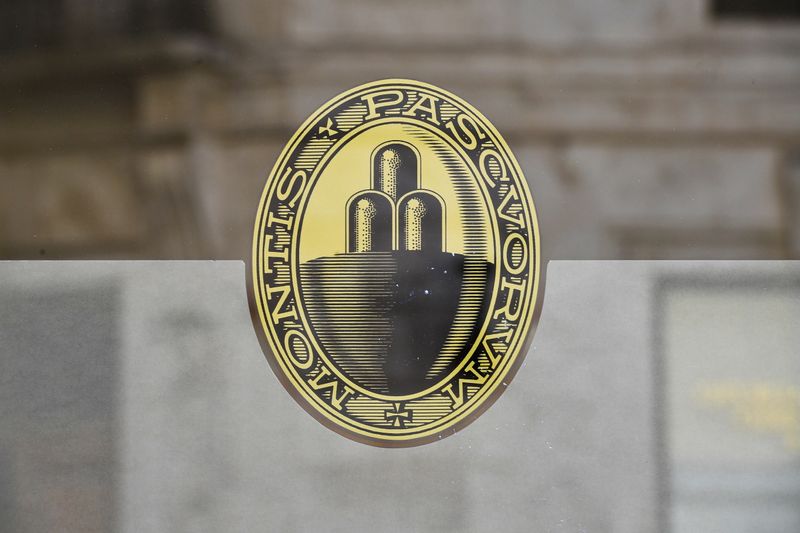MILAN (Reuters) – Four years after spending 5.4 billion euros ($6.3 billion) to rescue it, Rome is in talks to sell Monte dei Paschi to UniCredit and cut its 64% stake in the Tuscan bank.
Here is a timeline of key events in the recent history of Monte dei Paschi (MPS), which have made it the epitome of Italy’s banking nightmare.
NOVEMBER 2007 – MPS buys Antonveneta from Santander for 9 billion euros in cash, just months after the Spanish bank paid 6.6 billion euros for the Italian regional lender.
JANUARY 2008 – MPS announces a 5 billion euros rights issue, a 1 billion euro convertible financial instrument called Fresh 2008, 2 billion euros in subordinated, hybrid capital bonds and a 1.95 billion euro bridge loan to fund the Antonveneta deal.
MARCH 2008 – The Bank of Italy, led by Mario Draghi, approves the Antonveneta takeover subject to MPS rebuilding its capital.
MARCH 2009 – MPS sells 1.9 billion euros in special bonds to Italy’s Treasury to shore up its finances.
JULY 2011 – MPS raises 2.15 billion euros in a rights issue ahead of European stress test results.
SEPTEMBER 2011 – The Bank of Italy provides 6 billion euros in emergency liquidity to MPS through repo deals as the euro zone sovereign debt crisis escalates.
DECEMBER 2011 – The European Banking Authority sets MPS’ capital shortfall at 3.267 billion euros as part of a general recommendation to 71 lenders to boost their capital reserves.
FEBRUARY 2012 – MPS cuts its capital needs by 1 billion euros by converting hybrid capital instruments into shares.
MARCH 2012 – MPS posts a 4.7 billion euro 2011 loss after billions of goodwill writedowns on deals including Antonveneta.
MAY 2012 – Italian police search MPS headquarters as prosecutors investigate whether it misled regulators over the Antonveneta acquisition.
JUNE 2012 – MPS says it needs 1.3 billion euros in capital to comply with EBA’s recommendation.
JUNE 2012 – MPS asks Italy’s Treasury to underwrite up to another 2 billion euros in special bonds.
OCTOBER 2012 – Shareholders approve a 1 billion euro share issue aimed at new investors.
FEBRUARY 2013 – MPS says losses stemming from three 2006-09 derivatives trades amount to 730 million euros.
MARCH 2013 – MPS loses 3.17 billion euros in 2012, hit by plunging prices on its large Italian government bond holdings.
MARCH 2014 – MPS posts 2013 net loss of 1.44 billion euros.
JUNE 2014 – MPS raises 5 billion euros in a deeply discounted rights issue and repays the state 3.1 billion euros.
OCTOBER 2014 – MPS emerges as the worst performer in Europe-wide stress tests with a capital shortfall of 2.1 billion euros.
OCTOBER 2014 – The former MPS chairman, chief executive and finance chief are sentenced to three-and-a-half years in jail after being found guilty of misleading regulators.
NOVEMBER 2014 – MPS plans to raise up to 2.5 billion euros after stress tests results.
JUNE 2015 – MPS raises 3 billion euros in cash having upped the size of its rights issue after posting a 5.3 billion euro net loss for 2014 on record bad loan writedowns. It repays the remaining 1.1 billion euro state underwritten special bond.
JULY 2016 – MPS announces a new 5 billion euro rights issue and plans to offload 28 billion euros in bad loans as European bank stress tests show it would have negative equity in a slump.
DECEMBER 2016 – MPS turns to the state for help under a precautionary recapitalisation scheme after its cash call fails. The ECB sets the bank’s capital needs at 8.8 billion euros.
JULY 2017 – After the ECB declares MPS solvent, the EU Commission clears the bailout at a cost of 5.4 billion euros for the state in return for a 68% stake. Private investors contribute 2.8 billion euros for a total of 8.2 billion.
FEBRUARY 2018 – MPS swings to profit in 2018 but says its updated projections are below EU agreed restructuring targets.
OCTOBER 2018 – MPS completes Europe’s biggest bad loan securitisation deal, shedding 24 billion euros in bad debts.
FEBRUARY 2020 – MPS posts 1 billion euro 2019 loss.
MAY 2020 – CEO Marco Morelli steps down urging Rome to secure a partner for MPS as soon as possible. He is replaced by 5-Star backed Guido Bastianini.
AUGUST 2020 – Italy sets aside 1.5 billion euros to help MPS as it works to meet a mid-2022 re-privatisation deadline.
OCTOBER 2020 – MPS shareholders approve a state-sponsored plan to cut soured loans to 4.3% of total lending. Italy’s stake falls to 64% as a decree paves the way for its sale.
OCTOBER 2020 – A Milan court convicts MPS’ former CEO and chairman for false accounting in a surprise decision that forces MPS to boost legal risk provisions.
DECEMBER 2020 – MPS says it needs up to 2.5 billion euros in capital.
DECEMBER 2020 – Italy approves tax incentives for bank mergers entailing a 2.3 billion euro benefit for an MPS buyer.
JANUARY 2021 – MPS says to open its books to potential partners.
FEBRUARY 2021 – MPS posts 1.69 billion euro loss for 2020.
APRIL 2021 – Andrea Orcel takes over as UniCredit CEO.
JULY 2021 – UniCredit enters exclusive talks with Italy’s Treasury to buy “selected parts” of MPS, a day before European banking stress test results show the smaller bank’s capital would be wiped out in a slump.
($1 = 0.8527 euros)
(Reporting by Valentina Za; Editing by Alexander Smith)

























